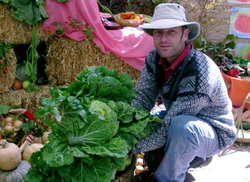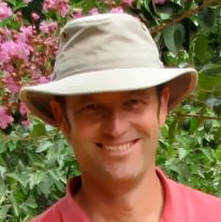Who are we?
|
Get Growing is the work of Tim Edmondson, accredited Registered Horticulturist (RH0022), Director, Horticulture - 2010 Australian Institute of Horticulturalist of the Year
For over 35 years, Tim has studied and worked in gardens around Canberra. Since 1998, Tim managed the grounds of the Orana School for Rudolf Steiner Education in Canberra. In 2003, the school grounds and several classrooms were devastated by bushfire. Tim managed the radical transformations of the school landscape that followed the fire. He provided organisation, planning and vision to raise Orana from the ashes. |
Tim applied sound horticultural principles and ‘Whole Farm’ planning methodologies to succeed and managed ‘Learnscapes’ to develop a masterplan for the school grounds. The plan was developed over 24 months in collaboration with the school community - teachers, management, students and parents. He completed the project in 2010.
Since mid-2011, Tim has been inspired to share his knowledge, experience and vision more widely, culminating in 'Get Growing'.
Since mid-2011, Tim has been inspired to share his knowledge, experience and vision more widely, culminating in 'Get Growing'.
AIH Horticulturalist of the year 2010
National Award for Canberra Landscape Project
The Australian Institute of Horticulture Inc (AIH) chose Tim Edmondson from the Orana Steiner School as the ‘Australian Horticulturist Of The Year” awarded for 2010.
Tim’s project came about from the devastating Canberra bushfires to create an oasis in the fire stricken school grounds.
The award recognizes Tim’s vision and leadership driving the community based smart ‘learnscape’, recovering from the 2003 Canberra fires and preparing for a hotter, drier future.
A unique and innovative water harvesting solution is used to future-proof the school grounds and respond to climate change. Trees planted by Orana’s students have outgrown expectations while cooling and beautifying the surrounds, setting a new standard for school grounds and environmental education.
The Australian Institute of Horticulture Inc (AIH) chose Tim Edmondson from the Orana Steiner School as the ‘Australian Horticulturist Of The Year” awarded for 2010.
Tim’s project came about from the devastating Canberra bushfires to create an oasis in the fire stricken school grounds.
The award recognizes Tim’s vision and leadership driving the community based smart ‘learnscape’, recovering from the 2003 Canberra fires and preparing for a hotter, drier future.
A unique and innovative water harvesting solution is used to future-proof the school grounds and respond to climate change. Trees planted by Orana’s students have outgrown expectations while cooling and beautifying the surrounds, setting a new standard for school grounds and environmental education.
AIH Award
The Australian Institute of Horticulture (AIH) celebrated its 50th year in 2010. The Institute was formed in Canberra (Australian Capital Territory) in 1953 and become an incorporated entity in 1960.
Since its inception AIH has become the pre-eminent national body that represents the interests of and professional development of horticulturists in Australia. AIH represents approximately 1000 members throughout Australia and overseas.
Since its inception AIH has become the pre-eminent national body that represents the interests of and professional development of horticulturists in Australia. AIH represents approximately 1000 members throughout Australia and overseas.
The Orana transformation
The Orana School in Weston Canberra was badly damaged in the 2003 bushfires. As well as losing buildings and sheds, many trees had to be removed. Grounds were badly burnt, resulting in the loss of most of the vegetation and the entire ecosystem of the school was disrupted.
The school shares its 13 hectare grounds with a mob of kangaroos, which depended on its grasses for nourishment. So their needs had to be considered, too.
Under Tim's leadership, the school planted native grasses and thousands of trees to stabilise the area, saved any topsoil that remained and re-establish biodiversity. As part of Tim's post-fire recovery plan, the Orana School also embarked upon a water conservation plan for the entire 13 hectares.
As new buildings were built, the water from down pipes was directed into 'creek beds' – specially made channels dug in the earth and lined with betonite, a canvas-like material impregnated with clay, which is used to line dams.
The channels were filled with sand, rocks and stones, giving them the appearance of a dry creek or river bed. These channels stored the water underground, minimising evaporation and allowing excess to flow into a larger subterranean dam where it could be pumped out for irrigation when needed.
Today, Orana's grounds are thriving again. The areas of water harvesting are increasing as students and teachers find new projects and the kangaroos are looking decidedly healthy.
The school shares its 13 hectare grounds with a mob of kangaroos, which depended on its grasses for nourishment. So their needs had to be considered, too.
Under Tim's leadership, the school planted native grasses and thousands of trees to stabilise the area, saved any topsoil that remained and re-establish biodiversity. As part of Tim's post-fire recovery plan, the Orana School also embarked upon a water conservation plan for the entire 13 hectares.
As new buildings were built, the water from down pipes was directed into 'creek beds' – specially made channels dug in the earth and lined with betonite, a canvas-like material impregnated with clay, which is used to line dams.
The channels were filled with sand, rocks and stones, giving them the appearance of a dry creek or river bed. These channels stored the water underground, minimising evaporation and allowing excess to flow into a larger subterranean dam where it could be pumped out for irrigation when needed.
Today, Orana's grounds are thriving again. The areas of water harvesting are increasing as students and teachers find new projects and the kangaroos are looking decidedly healthy.
A frog bog
The Orana School Year 6 students created a frog bog on a dry weed-covered patch of land behind their classrooms.
They cleared land cleared, stones and stored removed rocks for later use and created ponds or bogs by digging out areas of land slightly deeper than others.
They completed the landscape with shrubs, large rocks and stones. After the first the bog began to fill. Very soon after, the students discovered frogs inhabiting their new home.
They cleared land cleared, stones and stored removed rocks for later use and created ponds or bogs by digging out areas of land slightly deeper than others.
They completed the landscape with shrubs, large rocks and stones. After the first the bog began to fill. Very soon after, the students discovered frogs inhabiting their new home.
Veggie garden

The Orana School Year 8 students, as part of their bio-dynamic gardening course, decided to develop a vegetable garden using the same 'water harvesting' techniques. They choose a warm site, just north of the High School Resource Centre.
They dug, lined and filled channels in which they planted the vegetables. The veggies did not need much watering thanks to the water flowing from the Resource Centre downpipes filling the channels, which kept the plant roots moist.
The students received a 'Sustainable Cities Award' for their efforts. And even better than that, they enjoyed many scrumptious veggies harvested from the site.
They dug, lined and filled channels in which they planted the vegetables. The veggies did not need much watering thanks to the water flowing from the Resource Centre downpipes filling the channels, which kept the plant roots moist.
The students received a 'Sustainable Cities Award' for their efforts. And even better than that, they enjoyed many scrumptious veggies harvested from the site.
In the media
Home with heart
Published 2017, Modern Green Homes Sanctuary
Featuring an effective passive solar design, salvaged and recycled materials, and an innovative whole-block water harvesting system, this little owner-built home provides a comfortable base for a young Canberra family. Open for Sustainable House Day 2017.
When Shelley Dickerson was growing up, her family had an old 1970s caravan with a daybed in the kitchen. “It was the most sought-after spot in the caravan,” she remembers. So when it came to designing her own home with partner Luke, it was the first feature they wanted. Covered in a repurposed Turkish kilim rug, the daybed divides the living room and the kitchen in the family’s cosy Canberra home. “You can see all the goings-on in the house from here; it’s the heart of the place,” Shelley says.
If the daybed is the heart, the handcrafted, recycled materials form the soul of the home. The design was kept simple so that Luke, a carpenter, could build it by himself in his spare time and most of the joinery is recycled hardwood left over from his other projects. Other materials were salvaged, for environmental and money-saving reasons. It does come with a time cost, but Luke loves the process of recycling things, and says he gets great satisfaction from reusing materials. “The feeling you get at the end of the day is just so worth it.”
The couple took advantage of an ACT government ‘land rent’ system to make building their own house possible financially. “You lease the block for 99 years, meaning that you only need to borrow enough to build the house,” says Shelley. “For us, it was a good way to live in a beautiful spot – in Canberra’s inner west, in the foothills of the Brindabellas – without a huge mortgage.”
The two-storey house has three bedrooms and a studio, plus a split-level kitchen, dining and living area. It’s aligned so that all main rooms have a north window, and a big deck provides a good connection to the garden. Double glazing, good cross ventilation, a concrete slab for thermal mass, a heat pump for hot water and 3 kW of solar PV all assist with the all-electric house’s thermal performance and energy efficiency.
Luke and Shelley moved into the finished house with their two small children in December 2015. “It’s been the most satisfying experience, the whole thing. With its extremes of temperature, Canberra is a great place for a passive solar house – it’s just so effective. Having a house that copes well with very hot and very cold just changes your life.”
Whole-block water harvesting
Shelley and Luke’s “big splurge” on their house was the installation of a whole-block water harvesting system, designed by horticulturalist Tim Edmondson of Get Growing. “The important factors for plant growth are moisture, light and temperature; in Canberra, just as the temperature is coming up after winter, the available moisture starts to decline,” explains Tim. “This system ensures that during the optimum growing season, groundwater is freely available to plants.”
The system consists of 95 lineal metres of aquifers dug into the ground: these are trenches lined with a water-impermeable bentonite liner and filled with washed river sand. “When the sand is wet, it will hold a third of its volume in water,” says Tim. Rainwater runs from the roof into the aquifers, which can store around 2,850 litres; it then travels via capillary action into the soil and is taken up by the plants, much like a giant wicking bed.
Tim notes that the water harvesting system mimics apparently dry creek beds in the Australian bush. “Often you can’t see the water, but it’s there under the surface, moving through the sand and gravel layer and nourishing the trees.”
The system extends the watering period after rain by getting the water straight underground and storing it in the zone where plants can use it; the block’s stormwater outflow is also greatly reduced. In addition, part of the roof drains into a rainwater tank, which can be emptied into the aquifer system in low-rainfall periods.
Their water harvesting system cost around $9,500 and removes most of the need for human management, a boon for Shelley and Luke who describe themselves as hopeless gardeners!
Featuring an effective passive solar design, salvaged and recycled materials, and an innovative whole-block water harvesting system, this little owner-built home provides a comfortable base for a young Canberra family. Open for Sustainable House Day 2017.
When Shelley Dickerson was growing up, her family had an old 1970s caravan with a daybed in the kitchen. “It was the most sought-after spot in the caravan,” she remembers. So when it came to designing her own home with partner Luke, it was the first feature they wanted. Covered in a repurposed Turkish kilim rug, the daybed divides the living room and the kitchen in the family’s cosy Canberra home. “You can see all the goings-on in the house from here; it’s the heart of the place,” Shelley says.
If the daybed is the heart, the handcrafted, recycled materials form the soul of the home. The design was kept simple so that Luke, a carpenter, could build it by himself in his spare time and most of the joinery is recycled hardwood left over from his other projects. Other materials were salvaged, for environmental and money-saving reasons. It does come with a time cost, but Luke loves the process of recycling things, and says he gets great satisfaction from reusing materials. “The feeling you get at the end of the day is just so worth it.”
The couple took advantage of an ACT government ‘land rent’ system to make building their own house possible financially. “You lease the block for 99 years, meaning that you only need to borrow enough to build the house,” says Shelley. “For us, it was a good way to live in a beautiful spot – in Canberra’s inner west, in the foothills of the Brindabellas – without a huge mortgage.”
The two-storey house has three bedrooms and a studio, plus a split-level kitchen, dining and living area. It’s aligned so that all main rooms have a north window, and a big deck provides a good connection to the garden. Double glazing, good cross ventilation, a concrete slab for thermal mass, a heat pump for hot water and 3 kW of solar PV all assist with the all-electric house’s thermal performance and energy efficiency.
Luke and Shelley moved into the finished house with their two small children in December 2015. “It’s been the most satisfying experience, the whole thing. With its extremes of temperature, Canberra is a great place for a passive solar house – it’s just so effective. Having a house that copes well with very hot and very cold just changes your life.”
Whole-block water harvesting
Shelley and Luke’s “big splurge” on their house was the installation of a whole-block water harvesting system, designed by horticulturalist Tim Edmondson of Get Growing. “The important factors for plant growth are moisture, light and temperature; in Canberra, just as the temperature is coming up after winter, the available moisture starts to decline,” explains Tim. “This system ensures that during the optimum growing season, groundwater is freely available to plants.”
The system consists of 95 lineal metres of aquifers dug into the ground: these are trenches lined with a water-impermeable bentonite liner and filled with washed river sand. “When the sand is wet, it will hold a third of its volume in water,” says Tim. Rainwater runs from the roof into the aquifers, which can store around 2,850 litres; it then travels via capillary action into the soil and is taken up by the plants, much like a giant wicking bed.
Tim notes that the water harvesting system mimics apparently dry creek beds in the Australian bush. “Often you can’t see the water, but it’s there under the surface, moving through the sand and gravel layer and nourishing the trees.”
The system extends the watering period after rain by getting the water straight underground and storing it in the zone where plants can use it; the block’s stormwater outflow is also greatly reduced. In addition, part of the roof drains into a rainwater tank, which can be emptied into the aquifer system in low-rainfall periods.
Their water harvesting system cost around $9,500 and removes most of the need for human management, a boon for Shelley and Luke who describe themselves as hopeless gardeners!


